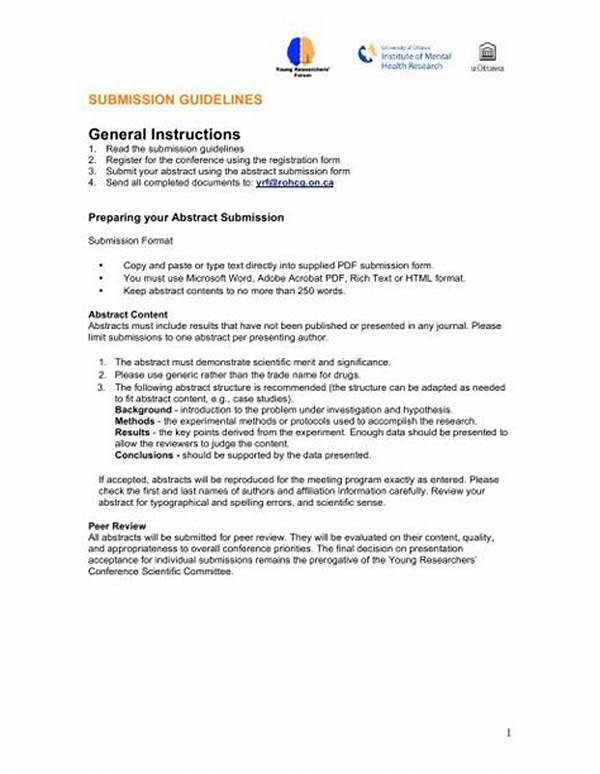In the realm of scientific research and communication, the submission of abstracts stands as a pivotal aspect of disseminating knowledge and advancing academic discourse. An abstract, succinctly summarizing the essence of a research study, serves as the gateway to broader engagement within the scientific community. The guidelines for scientific abstract submission are imperative as they ensure clarity, conciseness, and the conveyance of critical findings. This article will elucidate essential aspects and protocols to adhere to when embarking on the journey of abstract submission.
Read Now : Techniques For Consistent Data Measurement
Importance of Guidelines for Scientific Abstract Submission
The guidelines for scientific abstract submission underscore the need for coherence and precision. Abstracts are often the first, and sometimes the only, portion of research that conference organizers and peers evaluate. Hence, an effective abstract must encapsulate the purpose, methodology, results, and conclusions of the study in a clear and comprehensive manner. Adhering to these guidelines ensures that the submitted abstract meets the specific criteria set by journals or conferences, thereby increasing the likelihood of acceptance.
Moreover, the guidelines for scientific abstract submission facilitate the organization of scientific content. By adhering to structured formats, researchers can effectively communicate their findings to diverse audiences. This standardization not only aids in the readability and comprehension of the abstract but also assists reviewers and editors in assessing the merits of the submission. In doing so, researchers contribute to the progression of scientific inquiry by making their research accessible and understandable across varied disciplines.
Lastly, the adherence to guidelines for scientific abstract submission plays a fundamental role in maintaining the integrity of scientific communication. In an era where information is copious and rapidly disseminated, standardized abstract submissions help maintain a level of quality and reliability in scientific discourse. This ensures that only rigorously scrutinized and clearly presented research reaches the audiences, thereby preserving the credibility and value of scientific contributions.
Key Components in Guidelines for Scientific Abstract Submission
1. Clarity and Precision: The abstract must be written with clarity, free of jargon, and should precisely convey the study’s purpose and findings.
2. Structured Format: Typically, abstracts follow a structured format including the background, objectives, methods, results, and conclusion.
3. Word Limit Adherence: Guidelines for scientific abstract submission generally specify word limits, emphasizing brevity without sacrificing essential content.
4. Relevance and Novelty: It is crucial to highlight the novel contributions and relevance of the research to entice the interest of the reviewing committee.
5. Technical and Ethical Compliance: Compliance with ethical standards and technical formalities, such as ensuring the absence of typographical and grammatical errors, is paramount.
Crafting a Quality Abstract: A Deep Insight
The guidelines for scientific abstract submission are designed not only to facilitate the orderly presentation of scientific findings but also to promote thorough academic scrutiny. Submitting an abstract requires an understanding of these guidelines and integrating them into the writing process. Authors must ensure that the abstract stands as an independent representation of their work, effectively summarizing the full-length paper.
Read Now : Mindfulness And Muscle Relaxation
Conciseness is key in the process. Researchers must distill extensive studies into a condensed format that remains informative and engaging. This involves selecting only the most pertinent details that convey the significance and impact of the research. The language should be tailored to suit the audience, ensuring accessibility to both specialists and scholars from other disciplines. With stringent guidelines for scientific abstract submission in place, the challenge lies in balancing comprehensive coverage of the research with brevity.
Furthermore, throughout the creation of an abstract, attention must be paid to the alignment of the abstract’s message with the larger narrative of the research. The guidelines for scientific abstract submission often emphasize consistency between the abstract and the main body of the work, ensuring that promises made in the abstract are fulfilled by the detailed content. Consistency in terminology, methodology descriptions, and reported findings across both the abstract and the full paper validates the research’s authenticity and reliability.
Practical Considerations for Scientific Abstract Submission
In adhering to the guidelines for scientific abstract submission, there are practical considerations that researchers must be mindful of:
Enhancing Abstract Submission Effectiveness
Despite the challenges inherent in the process, adhering to guidelines for scientific abstract submission can significantly enhance the effectiveness of an abstract. It is incumbent upon researchers to stay informed about the evolving criteria set by different scientific bodies. This awareness ensures that each submission not only complies with existing standards but also reflects advancements in abstract writing and presentation techniques.
The synthesis of detailed research into a precise abstract aligns with the broader objectives of scientific communication—facilitating knowledge exchange and collaboration. Engaging with the guidelines for scientific abstract submission fosters a rigorous process of refinement and distillation of key research insights that ultimately advances the reach and impact of scientific endeavors. By honing the craft of abstract writing within these guidelines, researchers can better articulate their contributions to the scientific world.
Acknowledging the Role of Guidelines
The guidelines for scientific abstract submission are indispensable in an ever-expanding scientific landscape. They ensure each abstract is a coherent, standardized reflection of research efforts and achievements. As the preliminary means of communicating cutting-edge research findings, an abstract carries the responsibility of attracting attention and inciting scholarly dialogue. By earnestly adhering to these guidelines, researchers support the dissemination and application of scientific knowledge, reinforcing the bridge between research innovation and practical solutions to global challenges.
Importance of Preparing a Submission Strategy
Developing a submission strategy in line with the guidelines for scientific abstract submission equips researchers with a framework for success. This involves careful planning in choosing appropriate venues for submission, understanding their particular guidelines, and strategically aligning the abstract content with the objectives of these platforms. It is this strategic consideration that not only enhances acceptance rates but also amplifies the visibility and impact of the research. These efforts cumulatively contribute to the development of a robust scientific community committed to knowledge advancement and transformative discovery.
